Odometer moments are those times when we pass a number like 10,000, or any other number that ends with a few zero's. Remember the excitement when your "new" car reaches it's 10,000 mile mark? That's an odometer moment in action, and today we have an odometer moment in world population. It's estimated that today, Oct 31 2011, the human population of this planet has reached 7 billion people. In practical terms the difference between 6.999 billion and 7 billion is small, but these odometer moments offer an opportunity to reflect on where we're headed.
There's a basic fact here, the rate of population growth has sped up considerably since 1800 when world human population first surpassed 1 billion people.
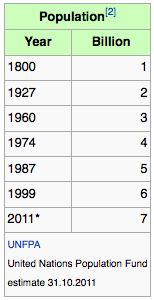
The chart at the right shows population odometer moments since 1800. What's most important about that table is the period of years between each odometer moment. First, 127 years, then 33 years, then 14 years, then 13 years, then 12 years and again 12 years. That means for the last 30-40 years it's taking 12-3 years to add a billion people to the planets human population.
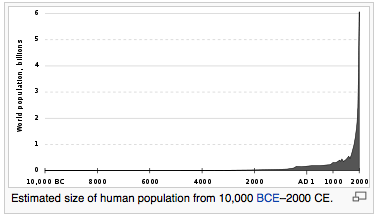
Here's another way to graph human population over time. Mathematically this is an exponential growth curve. Exponential curves are dangerous because they tend to explode.
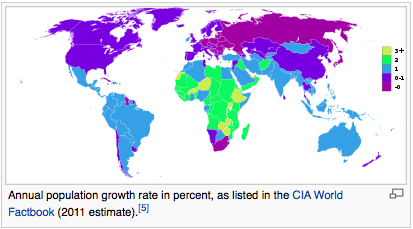
This chart shows where population growth hotspots currently exist. The highest growth rates are colored in shades of green, and occur primarily in Africa, with other high population growth areas in Yemen, Oman, Iraq and Afghanistan.
India, one of the population powerhouses, is ominously growing at a fairly rapid rate whereas the other population powerhouse, China, is growing at a slower rate.
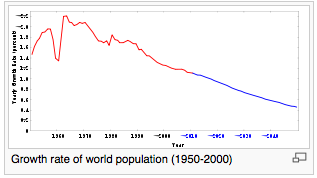
Fortunately the actual rate of population growth is slowing down. There have been years of efforts to slow down population growth because many recognize the problem which can occur from overpopulation.
Overpopulation is a condition where an organism's numbers exceed the carrying capacity of its habitat. Humanity has "agriculture" and "medical advances" to thank for the population growth. If we think over history it's clear human families can bear quite a few children, but that disease will kill most of them. Medical advances prevent childhood diseases from killing so many people and as a result our population is growing.
Modern agriculture has made tremendous strides in food production.
The recent rapid increase in human population over the past two centuries has raised concerns that humans are beginning to overpopulate the Earth, and that the planet may not be able to sustain present or larger numbers of inhabitants. However, the rate of population growth has been declining since the 1980s, and is expected to stabilize by around the middle of the 21st century. Unlike global warming, which has recently become considered nearly fact by the scientific community, many scientists do not believe that the world is overpopulated, and believe instead that waste and over-consumption, especially by wealthy nations, is the force putting strain on the environment.
The carrying capacity of a biological species in an environment is the maximum population size of the species that the environment can sustain indefinitely, given the food, habitat, water and other necessities available in the environment.
The concern is that the human population is exceeding the carrying capacity of this planet. Not all population growth is the same. Paul Erlich developed the IPAT equation to summarize the effect of population based on technological capability:
- I = P * A * T
where:
- I is the impact on the environment resulting from consumption
- P is the population number
- A is the consumption per capita (affluence)
- T is the technology factor
7 billion agrarians hunting and gathering have a smaller impact than 7 billion car owning humans following the American over-consumptive lifestyle.
America with 6% or so of world population consumes 25% or more of world resource production. Per-capita our impact on the planet's wellbeing is greater than the per-capita impact of a tribal farmer in remote Africa.
Overexploitation, also called overharvesting, refers to harvesting a renewable resource to the point of diminishing returns. Sustained overexploitation can lead to the destruction of the resource.
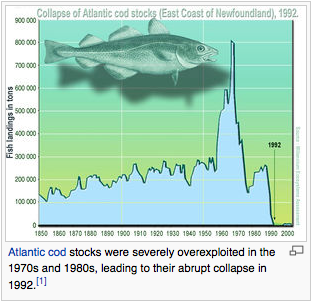
This chart shows the effect of over-exploitation of cod fisheries in the North Atlantic. That fish used to be a primary source of food in America but by 1992 the Cod fishery totally collapsed. All along the coast from NY City up to Canada former fishing villages have run into serious economic trouble after the fishery collapsed.
This is presented as an example of effects of over-population and over-consumption. It shows a period of over-exploitation beginning in the early 1950's perhaps driven by the "Baby Boom" and improved fishery technology including the use of SONAR to track fish populations so the fishermen could do a better job of harvesting fish.
It's thought that by 2050 all large fish in the ocean will be extinct, due to over-fishing.
I want to end this by linking to Dr. Al Bartlett's seminal lecture, "Arithmetic, Population, and Energy." The argument is that if you look at the numbers, infinite growth is impossible and exponential growth patterns lead to crashes.






